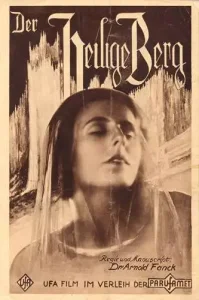Peaks of Passion, Shadows of Destiny: How Leni Riefenstahl's 'The Holy Mountain' (1926) Carved a Legend in Early Cinema!
In the silent, burgeoning era of German cinema, the "Bergfilm" or "Mountain Film" genre emerged as a unique and influential cinematic movement, captivating audiences with its dramatic narratives set against the awe-inspiring, often perilous, backdrop of the Alps. These films, often characterized by themes of human endurance, spiritual quest, and the raw power of nature, provided a stark contrast to the urban dramas and expressionistic horrors prevalent at the time. At the forefront of this genre, both as a mesmerizing actress and later as its most controversial director, stood Leni Riefenstahl. Her starring role in The Holy Mountain (1926), or Der Heilige Berg, is not merely a performance; it is a foundational moment, showcasing her athletic grace and magnetic screen presence that would define the archetype of the "mountain girl." Directed by the genre's pioneer Arnold Fanck, this film stands as a significant historical artifact, a visually stunning epic that demonstrated the poetic grandeur of the natural world and cemented Riefenstahl's early star power, paving the way for her later, far more infamous, directorial career and forever linking her to the aesthetic power of monumental landscapes.
The Holy Mountain plunges into a romanticized world of mountain climbing, dance, and tragic rivalry. It centers on Diotima (Leni Riefenstahl), a beautiful and ethereal dancer whose performances captivate two close friends, both avid mountaineers: Karl (Luis Trenker) and Vigo (Ernst Petersen). The tranquil bond between the two men shatters as they both fall passionately in love with Diotima, leading to a tense, unspoken rivalry that escalates against the majestic, unforgiving peaks of the mountains. The film beautifully captures the allure and danger of the alpine world, portraying mountaineering not just as a sport, but as a spiritual endeavor, a test of will and destiny. As the emotional stakes rise, the dramatic tension culminates in a perilous ascent, where the raw forces of nature and the burning passions of men collide in a tragic, unforgettable climax, cementing the mountain itself as a powerful, almost sentient, character in the unfolding drama.
Arnold Fanck's direction is a masterclass in silent film spectacle, utilizing innovative cinematography to capture the breathtaking beauty and immense scale of the high Alps. His use of real locations, daring camera work (often involving actual mountain climbers and skiers), and a meticulous attention to the dynamics of the natural world created a visual language that was revolutionary for its time. The film is a symphony of sweeping vistas, dramatic avalanches, and intimate close-ups, all choreographed to convey the characters' inner turmoil against the backdrop of an indifferent, yet awe-inspiring, wilderness. The editing builds suspense masterfully, particularly during the perilous climbing sequences, immersing the audience in the physical and emotional struggle of the characters. It's a testament to Fanck's vision that the film still manages to evoke a sense of grandeur and peril almost a century later, proving the timeless power of human drama set against nature's might.
While The Holy Mountain is primarily celebrated for its stunning visuals and its contribution to the Bergfilm genre, it also holds significant historical weight due to its star. Leni Riefenstahl (who was also heavily involved in the film's development) delivers a captivating performance, embodying the film's central enigma with a blend of grace and intensity that marked her as a unique screen presence. Luis Trenker and Ernst Petersen provide strong, stoic performances as the mountaineers caught in the throes of love and rivalry. The film was a major commercial success in Germany and solidified Fanck's reputation as the genre's leading director. Though The Holy Mountain predates Riefenstahl's later, highly controversial propaganda work for the Nazi regime, it offers a fascinating glimpse into the nascent visual language and themes that would later define her controversial oeuvre, making it a crucial, if complex, entry in film history.
Director: Arnold Fanck.
Cast: Leni Riefenstahl as Diotima, Luis Trenker as Karl, Ernst Petersen as Vigo, and Frida Richard as the Mother.
Special Info/Trivia: This film is a seminal example of the German "Bergfilm" (Mountain Film) genre. It starred Leni Riefenstahl early in her career, before she became a director (and later, a propagandist for the Nazi regime). The film was shot on location in the Alps, employing real mountaineers and pioneering daring cinematography in extreme conditions. It was a commercial success upon its release in Germany. Riefenstahl herself was an accomplished dancer and mountaineer, which informed her role.

